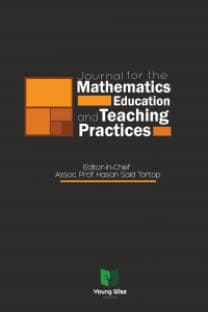Overview of Elementary Students Knowledge Creation Using Dynamic Geometry Environment
___
- Afzal, M. N. I., & Lawrey, R. (2012). Investigating World Bank knowledge assessment methodology (KAM) using data envelopment analysis (DEA): a study in the ASEAN region. Research Journal of Science & IT Management, 1(October), 33–38.
- Baxter, P., & Jack, S. (2008). Qualitative case study methodology: Study design and implementation for novice researchers. The Qualitative Report, 13(4), 544‒559.
- Brown, C., & Rogers, S. (2014). Measuring the effectiveness of knowledge creation as a means of facilitating evidence-informed practice in early years settings in one London borough. London Review of Education, 12(3), 245–260. https://doi.org/10.18546/LRE.12.3.01
- Brown, J. S., & Duguid, P. (2002). The Social Life of Information. Harvard: Harvard Business School Press. https://doi.org/10.1016/S0016-3287(00)00065-3
- Chen, Y., Dellea, D., & Bianchi, G. (2019). Knowledge Creation and Research Production in Swiss Hotel Schools: A Case Study of the Ecole hôtelière de Lausanne. Journal of Hospitality and Tourism Education, 31(1), 10–22. https://doi.org/10.1080/10963758.2018.1480960
- Cheng, E. C. K. (2019). Successful Transposition of Lesson Study. In Applying SECI Model for Creating Pedagogical Knowledge (pp. 29–44). https://doi.org/10.1007/978-981-13-2472-7
- Farnese, M. L., Barbieri, B., Chirumbolo, A., & Patriotta, G. (2019). Managing knowledge in organizations: A nonaka’s SECI model operationalization. Frontiers in Psychology, 10(December), 1–15. https://doi.org/10.3389/fpsyg.2019.02730
- Flanagin, A. J. (2002). The elusive benefits of the technological support of knowledge management. Management Communication Quarterly, 16(2), 242–248.
- Hartner-Tiefenthaler, M., Roetzer, K., Bottaro, G., & Peschl, M. F. (2018). When relational and epistemological uncertainty act as driving forces in collaborative knowledge creation processes among university students. Thinking Skills and Creativity, 28, 21–40. https://doi.org/10.1016/j.tsc.2018.02.013
- Huang, J. J. (2009). The evolutionary perspective of knowledge creation - A mathematical representation. Knowledge-Based Systems, 22(6), 430–438. https://doi.org/10.1016/j.knosys.2009.05.008
- Johannessen, J. A., Olaisen, J., & Olsen, B. (2001). Mismanagement of tacit knowledge: the importance of tacit knowledge, the danger of information technology, and what to do about it. International Journal of Information Management, 21(1), 3–20.
- Jones, K. (1999). Student interpretations of a dynamic geometry environment. European Research in Mathematics Education I, 2(May), 245–258. Retrieved from http://eprints.soton.ac.uk/41224/
- Kao, S. C., & Wu, C. H. (2016). The role of creation mode and social networking mode in knowledge creation performance: Mediation effect of creation process. Information and Management, 53(6), 803–816. https://doi.org/10.1016/j.im.2016.03.002
- Koloniari, M., Vraimaki, E., & Fassoulis, K. (2018). Fostering Innovation in Academic Libraries Through Knowledge Creation. Journal of Academic Librarianship, (May), 1–12. https://doi.org/10.1016/j.acalib.2018.09.016
- Kuzle, A. (2013). Patterns of metacognitive behavior during mathematics problem-solving in a dynamic geometry environment. International Electronic Journal of Mathematics Education, 8(1), 20–40.
- Lopez-Nicolas, C., & Soto-Acosta, P. (2010). Analyzing ICT adoption and use effects on knowledge creation: An empirical investigation in SMEs. International Journal of Information Management, 30(6), 521–528. https://doi.org/10.1016/j.ijinfomgt.2010.03.004
- Marbán, J. M., & Mulenga, E. M. (2019). Pre-service Primary Teachers’ Teaching Styles and Attitudes towards the Use of Technology in Mathematics Classrooms. International Electronic Journal of Mathematics Education, 14(2), 253–263. https://doi.org/10.29333/iejme/5649
- Merriam, S. B. (1998). Qualitative Research and Case Study Applications in Education. San Fransisco: Jossey-Bass Publishers.
- Nonaka, I., Toyama, R., & Byosiere, P. (2001). A theory of organizational knowledge creation: understanding the dynamic process of creating knowledge. In M. Dierkes, A. B. Antal, J. Child, & I. Nonaka (Eds.), Handbook of organizational learning and knowledge (pp. 487–491). Oxford: Oxford University Press.
- Paavola, S., & Hakkarainen, K. (2005). The knowledge creation metaphor - An emergent epistemological approach to learning. Science and Education, 14(6), 535–557. https://doi.org/10.1007/s11191-004-5157-0
- Sanz-Valle, R., Jime´nez-Jime´nez, D., Perez-Caballero, L., & Naranjo-Valencia, J. C. (2011). Linking organizational learning with technical innovation and organizational culture. Journal of Knowledge Management, 15(6), 997–1015.
- So, H.-J., & Tan, E. (2014). Knowledge Creation in Education. Knowledge Creation in Education, 123–142. https://doi.org/10.1007/978-981-287-047-6
- Steedle, J. T. (2017). Descriptive Statistics. In D. Wyse, N. Selwyn, E. Smith, & L. E. Suter (Eds.), The BERA/SAGE Handbook of Educational Research: Two Volume Set. London: SAGE Publication. https://doi.org/http://dx.doi.org/10.4135/9781473983953.n36
- Wahid, A. N., & Sudharatna, Y. (2016). Assessing Perceived Knowledge Creation: The Role of Organizational Knowledge and Market Environment. International Journal of Management, Knowledge and Learning, (1), 57–79.
- Yayın Aralığı: Yılda 2 Sayı
- Başlangıç: 2020
- Yayıncı: Genç Bilge Yayıncılık
Fredi GANDA PUTRA, Santi WİDYAWATİ, Komarudin KOMARUDİN, Suci ARYANİ
Aan Subhan PAMUNGKAS, Etika KHAERUNNİSA
Chusnul CHOTİMAH, Miftakhul JANNAH
Rinda Eka PUSPİTASARİ, Mohammad FAİZAL AMİR
Muhammad Noor KHOLID, Cholis SA'DIJAH, Erry HİDAYANTO, Hendro PERMADİ, Rizka Mafida Feby FIRDAREZA
